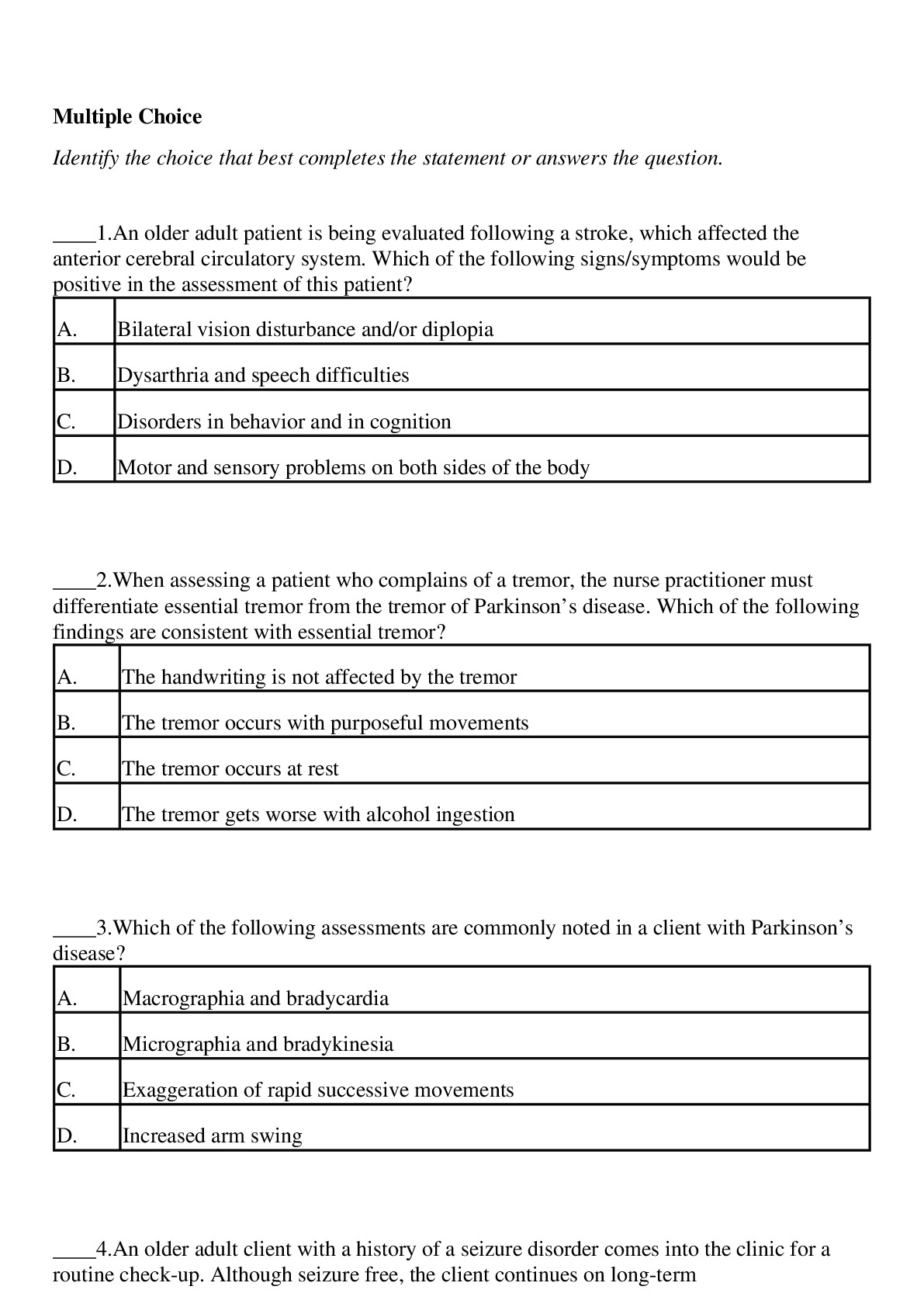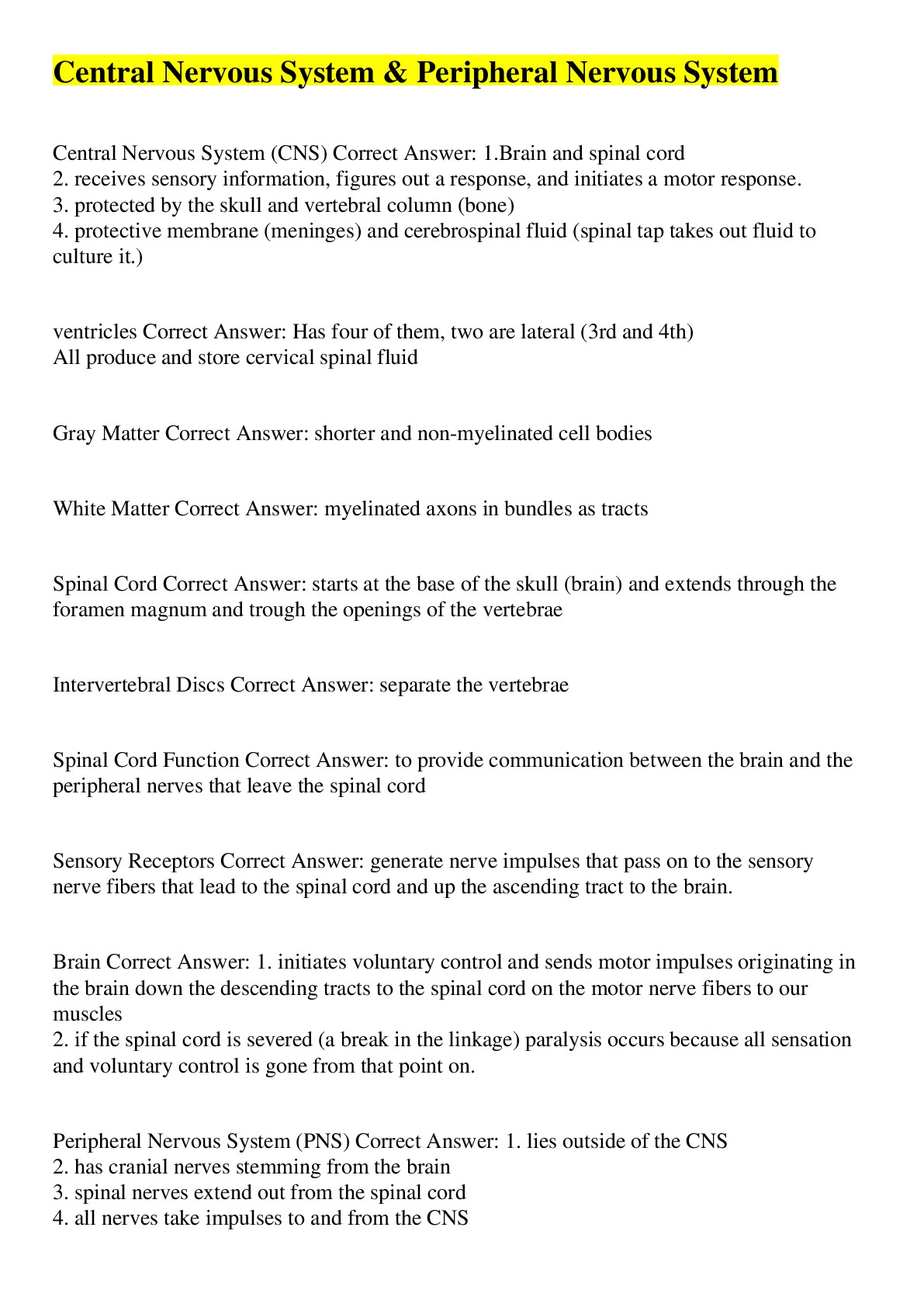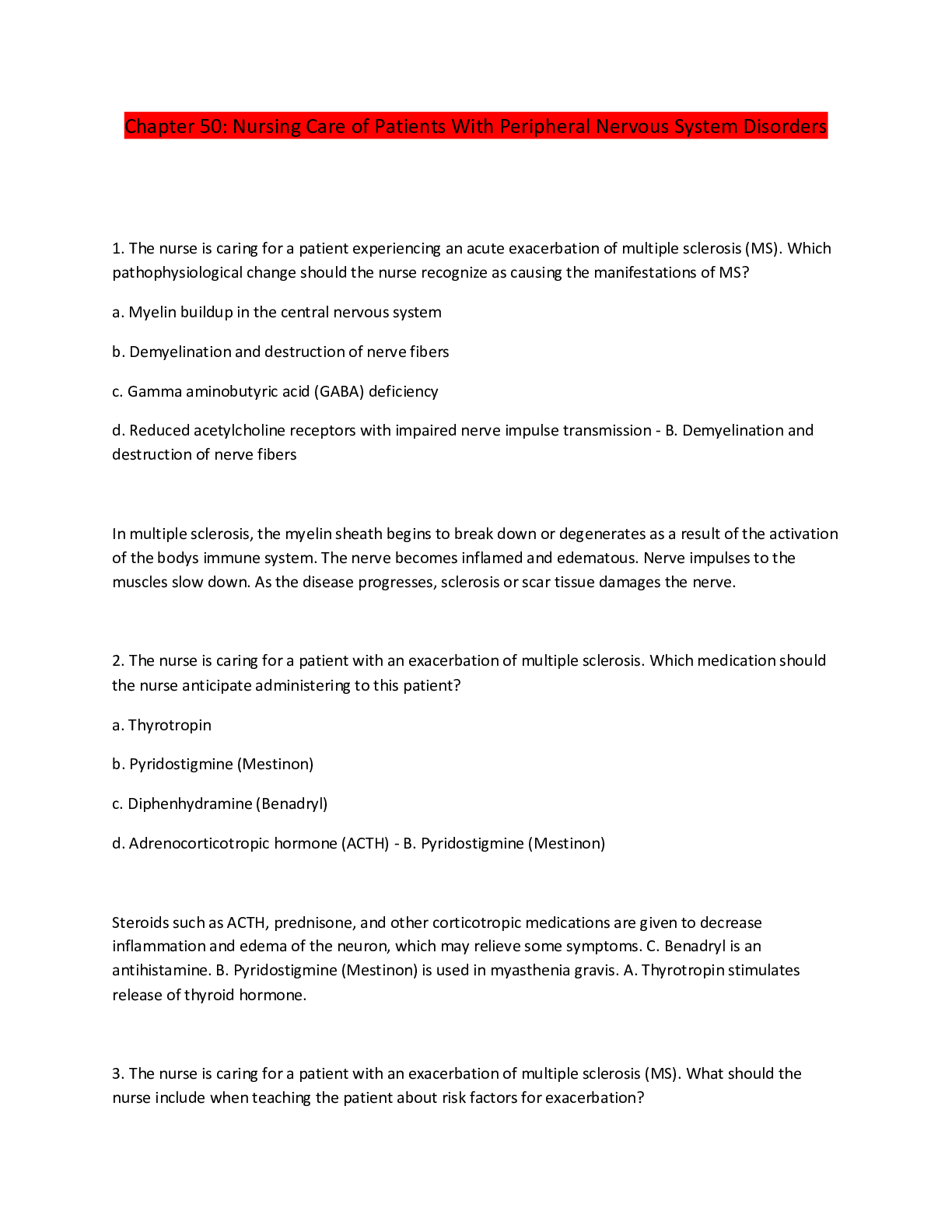*NURSING > EXAM > NR 601:Chapter 13: Central and Peripheral Nervous System Disorders,100% CORRECT (All)
NR 601:Chapter 13: Central and Peripheral Nervous System Disorders,100% CORRECT
Document Content and Description Below
Multiple Choice Identify the choice that best completes the statement or answers the question. ____ 1. An older adult patient is being evaluated following a stroke, which affected the anterior cer... ebral circulatory system. Which of the following signs/symptoms would be positive in the assessment of this patient? A. Bilateral vision disturbance and/or diplopia B. Dysarthria and speech difficulties C. Disorders in behavior and in cognition D. Motor and sensory problems on both sides of the body ____ 2. When assessing a patient who complains of a tremor, the nurse practitioner must differentiate essential tremor from the tremor of Parkinson’s disease. Which of the following findings are consistent with essential tremor? A. The handwriting is not affected by the tremor B. The tremor occurs with purposeful movements C. The tremor occurs at rest D. The tremor gets worse with alcohol ingestion ____ 3. Which of the following assessments are commonly noted in a client with Parkinson’s disease? A. Macrographia and bradycardia B. Micrographia and bradykinesia C. Exaggeration of rapid successive movements D. Increased arm swing ____ 4. An older adult client with a history of a seizure disorder comes into the clinic for a routine check-up. Although seizure free, the client continues on long-term phenytoin treatment. The nurse practitioner would assess for which of the following long-term effects? A. Lid lag and nystagmus B. Gingival hyperplasia and nystagmus C. Nystagmus and microcytic anemia D. Gingival hyperplasia and iron deficiency anemia ____ 5. An elderly nursing home resident is maintained on phenytoin therapy for a history of a seizure disorder. In addition to periodic serum drug concentrations, which of the following are needed for annual evaluation? A. Complete blood count, liver function tests, and renal function tests B. Complete blood count, liver function tests, and platelet count C. Renal function and calculated creatinine clearance D. Serum albumin, liver function tests, and renal function tests ____ 6. A 78-year-old female presents with a seizure that occurred over the weekend. In selecting the most important diagnostics for this presentation, it is important to know that the least common site of seizures in the elderly is: A. Cerebellum B. Frontal lobe C. Temporal lobe D. Parietal lobe ____ 7. An elderly patient has had a CVA in the anterior cerebral circulatory system (frontal lobe). What symptoms are most likely expressed? A. Neglect of body and difficulty organizing space B. Wernicke’s aphasia (difficulty understanding speech) C. Disorders of behavior and cognition D. Bilateral motor and sensory problem ____ 8. The most common neurological cause of seizures in an older adult is: A. Alzheimer’s disease B. Multiple sclerosis C. Stroke D. Peripheral neuropathy ____ 9. You are evaluating an elderly patient’s complaint of a new onset of “hand shaking” when he drinks from a cup. The patient is euthyroid and does not drink alcohol. Which of the following signs indicate that this tremor is most likely an essential tremor rather than a Parkinson’s tremor? A. It is characteristic of “pill rolling” and occurs at rest B. It is a moderate amplitude tremor that occurs only with movement/activity C. The tremor is also associated with slowed movements D. The tremor is accompanied by dyskinesia ____ 10. Mr. Andrews experienced a brief onset of right-sided weakness, slurred speech, and confusion yesterday. The symptoms have resolved. What should the nurse practitioner do? A. Assure the patient that he will not experience the symptoms again B. Identify modifiable cardiovascular risk factors C. Do a thorough medication review and a CT scan D. Order a stat EEG and administer O2 by mask ____ 11. An older male patient is experiencing acute onset of right-sided weakness, slurred speech, and confusion. What should the nurse practitioner do promptly? A. Administer an aspirin by mouth B. Evaluate for stroke and arrange transport to the hospital right away C. Do a thorough medication review and stat blood sugar D. Order an EKG and administer O2 by cannula immediately ____ 12. An older adult female patient had a stroke. What symptoms are not usually expressed by patients who have had a vertebrobasilar stroke? A. Vertigo B. Ataxia C. Dysarthria D. Monocular blindness ____ 13. When assessing an elderly client who reports a tremor, which assessment findings would be most reliable in identifying Parkinson’s disease? A. Any presence of tremor B. Symptoms of slowed movement, unstable angina, and tremor C. Resting tremor, slow unsteady gait, and cogwheel resistance D. Cogwheel rigidity, bradykinesia, and amnesia ____ 14. A 78-year-old man with Parkinson’s disease is being cared for in a nursing home. The nurses observe that he coughs at mealtime; he has the ability to still feed himself with adaptive equipment. He has had no aspirations. Oral exam is normal, except during his swallowing assessment you note there is slight delayed elicitation. You assess that he has only mild dysphagia. You recommend which of the following as the next step in his care? A. Consult gastroenterologist for g-tube decision B. Consult speech pathologist for video fluoroscopy C. Provide a trial of foods of differing consistency D. Require that he is fed all his meals ____ 15. Which of the following assessment findings is commonly noted in a client with advanced Parkinson’s disease? A. Macrographia B. Micrographia C. Ataxic gait D. Increased arm swing ____ 16. A middle-aged patient has been diagnosed with Parkinson’s disease. What influences the nurse practitioner’s decision to begin pharmacological treatment for this patient? A. Intentional tremors B. Gait instability requiring use of a cane C. Symptoms interfering with functional ability D. Medications initiated at first sign of unilateral involvement ____ 17. An older male presents with incontinence, has a wide-based and irregular gait, and progressive dementia. Which of the following presents with these cardinal signs? A. Parkinson’s disease B. Normal pressure hydrocephalus C. Basilar artery CVA D. Progressive supranuclear palsy ____ 18. In review of a nursing home patient’s chart, the nurse practitioner discovers that the neurology consult identified that the client has a homonymous hemianopsia. Which of the following statements accurately describes these findings? A. Partial loss of visual acuity in the ipsilateral peripheral fields B. Diplopia in the eye contralateral to the cerebral lesion C. Loss of vision in either the right or left halves of the visual fields D. Nystagmus in both eyes with asymmetrical movement ____ 19. The Mini-Cog is a short screening tool used to assess cognition. Which of the following statements pertaining to the test is a true statement? A. The patient will be asked to repeat five words immediately following the directions by the practitioner. B. The patient is asked to draw the hour and minute hands on a picture of an analog clock. C. A score of 0-2 is a positive screen for dementia. D. The patient is asked to recall five images from picture cards following the drawing of the clock hands. [Show More]
Last updated: 1 year ago
Preview 1 out of 8 pages

Buy this document to get the full access instantly
Instant Download Access after purchase
Add to cartInstant download
We Accept:

Reviews( 0 )
$13.00
Document information
Connected school, study & course
About the document
Uploaded On
Feb 04, 2021
Number of pages
8
Written in
Additional information
This document has been written for:
Uploaded
Feb 04, 2021
Downloads
0
Views
43













.png)




